Alfred, Lord Tennyson facts for kids
Quick facts for kids
The Lord Tennyson
|
|
|---|---|

Cabinet card by Elliott & Fry, late 1860s
|
|
| Poet Laureate of the United Kingdom | |
| In office 19 November 1850 – 6 October 1892 |
|
| Monarch | Victoria |
| Preceded by | William Wordsworth |
| Succeeded by | Alfred Austin |
| Member of the House of Lords Lord Temporal |
|
| In office 11 March 1884 – 6 October 1892 Hereditary Peerage |
|
| Succeeded by | Hallam Tennyson, 2nd Baron Tennyson |
| Personal details | |
| Born | 6 August 1809 Somersby, Lincolnshire, England |
| Died | 6 October 1892 (aged 83) Lurgashall, Sussex, England |
| Resting place | Westminster Abbey |
| Spouse |
Emily Sellwood
(m. 1850) |
| Children | |
| Alma mater | Trinity College, Cambridge (no degree) |
| Occupation | Poet Laureate (1850–1892) |
Alfred Tennyson, 1st Baron Tennyson (born August 6, 1809 – died October 6, 1892) was a famous English poet. He was the official poet for much of Queen Victoria's time as queen. This special job was called the Poet Laureate.
Tennyson won an important award at Cambridge University in 1829 for his poem "Timbuktu". In 1830, he published his first book of poems. It included popular poems like "Claribel" and "Mariana". Even though some people thought his poems were too emotional, many famous writers noticed his talent. His early poems, with their old-fashioned style and strong pictures, greatly influenced a group of artists called the Pre-Raphaelite Brotherhood.
Tennyson was also very good at writing short poems. Some of his well-known short works include "Break, Break, Break", "The Charge of the Light Brigade", and "Tears, Idle Tears". Many of his poems were based on old Greek and Roman myths, like "Ulysses". He wrote "In Memoriam A.H.H." to remember his close friend, Arthur Hallam, who passed away young. Tennyson also wrote poems without rhyme, called blank verse, such as Idylls of the King. He tried writing plays, but they were not very successful.
Many phrases from Tennyson's poems are still used today. For example, "Nature, red in tooth and claw" and "'Tis better to have loved and lost / Than never to have loved at all." He is one of the most quoted writers in The Oxford Dictionary of Quotations.
Contents
Biography
Early Life and Family
Alfred Tennyson was born on August 6, 1809, in a village called Somersby, England. His family was well-off and had some land. His father, George Clayton Tennyson, was a church leader. He was very talented in many areas, including art, music, and writing. He made sure his children received a good education. The family often spent summers by the sea.
Alfred and two of his older brothers started writing poetry when they were teenagers. A collection of their poems was published when Alfred was only 17. One of his brothers, Edward, had to live in a special care home.
School and First Poems

Tennyson went to King Edward VI Grammar School, Louth from 1816 to 1820. In 1827, he went to Trinity College, Cambridge University. There, he joined a secret group called the Cambridge Apostles.
At Cambridge, Tennyson became very good friends with Arthur Hallam and William Henry Brookfield. His first published work was a collection of poems he wrote with his older brother Charles. It was called Poems by Two Brothers and came out in 1827.
In 1829, Tennyson won a special award at Cambridge for his poem "Timbuktu." This was a big honor for a young man. In 1830, he published his first book of poems by himself, called Poems Chiefly Lyrical. This book included "Claribel" and "Mariana", which became some of his most famous poems. Even though some critics didn't like them, his poems quickly became popular. This brought him to the attention of famous writers like Samuel Taylor Coleridge.
Moving and More Poems
In 1831, Tennyson's father died. This meant Alfred had to leave Cambridge University before finishing his degree. He went back home to help his mother and family. His friend Arthur Hallam visited and got engaged to Tennyson's sister, Emilia.
In 1833, Tennyson published his second book of poetry. It included the first version of "The Lady of Shalott". This book received harsh criticism, which made Tennyson stop publishing for ten years. However, he kept writing during this time. In the same year, his friend Arthur Hallam died suddenly from a brain bleed while on vacation. Hallam's death deeply affected Tennyson. It inspired many poems, including "In Memoriam A.H.H.", a long poem about dealing with loss.
Around 1837, Tennyson and his family moved to Beech Hill Park in Epping Forest, Essex. Tennyson liked being close to London to see his friends. However, he couldn't stay in the city because his mother was very nervous. Tennyson also lost a lot of his family's money due to a bad investment. This caused him to suffer from serious sadness. In 1839, Tennyson met Thomas Carlyle, and they became lifelong friends. Tennyson moved to London in 1840.
Becoming Famous
On May 14, 1842, Tennyson published a two-volume collection of poems called Poems. The first volume had poems he had already published, and the second had almost all new ones. These poems were an instant success. Poems like "Locksley Hall", "Break, Break, Break", and "Ulysses" became very famous. A poem called "The Princess: A Medley" (1847), which made fun of women's education, was also popular for its songs.
The year 1850 was a very important year for Tennyson. He published his most famous work, "In Memoriam A.H.H.", which was dedicated to his friend Arthur Hallam. Later that year, he was chosen to be the Poet Laureate, taking over from William Wordsworth. Also in 1850, on June 13, Tennyson married Emily Sellwood, whom he had known since he was a child. They had two sons, Hallam (born 1852) and Lionel (born 1854). Hallam was named after his friend.
In 1853, Tennyson rented Farringford House on the Isle of Wight, and later bought it. He eventually found that too many curious tourists bothered him there. So, in 1869, he moved to Aldworth in West Sussex. But he still kept Farringford and went back there every winter.
-
Tennyson with his wife Emily (1813–1896) and his sons Hallam (1852–1928) and Lionel (1854–1886)
-
Farringford – Lord Tennyson's residence on the Isle of Wight
-
Alfred Tennyson, 1st Baron Tennyson, by George Frederic Watts (1817–1904)
Poet Laureate
In 1850, Tennyson became the Poet Laureate. This was after William Wordsworth died. He held this important job until his own death in 1892, which was the longest time anyone had been Poet Laureate. Part of his job was to write poems for special royal events. For example, he wrote a poem to welcome Princess Alexandra when she came to marry the future King Edward VII.
In 1855, Tennyson wrote one of his most famous poems, "The Charge of the Light Brigade". This poem honored British soldiers who made a brave but risky charge during the Crimean War. Other important poems he wrote as Poet Laureate include "Ode on the Death of the Duke of Wellington".
Tennyson was offered a special title by the Prime Minister, Benjamin Disraeli, in 1865 and 1868, but he said no. Finally, in 1883, he accepted a title from Prime Minister William Ewart Gladstone. In 1884, Queen Victoria made him Baron Tennyson. This meant he became a Lord and could sit in the House of Lords.
Tennyson also wrote poems about politics. He believed that society should improve slowly and steadily, not through sudden changes. He supported the idea of people having more say in government, but only after they were well-educated.
Towards the end of his life, Tennyson's religious beliefs were quite unique. He believed in a God that was part of everything. He famously wrote, "There lives more faith in honest doubt, believe me, than in half the creeds." This means he thought it was better to question and wonder than to just blindly follow beliefs.
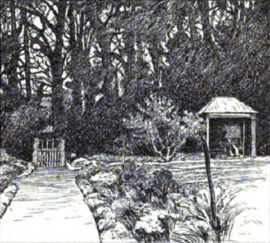
Tennyson continued writing poems even when he was in his eighties. He passed away on October 6, 1892, at the age of 83. He was buried in Westminster Abbey, a very famous church in London. A monument to him stands on Tennyson Down on the Isle of Wight, a place named after him.
His son, Hallam, became the next Baron Tennyson. Hallam later wrote a book about his father's life.
Tennyson and the Queen
Albert, Prince Consort, Queen Victoria's husband, helped Tennyson become Poet Laureate. Queen Victoria herself greatly admired Tennyson's poems. She wrote in her diary that she felt "much soothed & pleased" by reading "In Memoriam A.H.H." after Albert died.
They met twice. The first time was in April 1862. Victoria wrote that Tennyson was "very peculiar looking, tall, dark, with a fine head, long black flowing hair & a beard, oddly dressed, but there is no affectation about him."
They met again in August 1883. The Queen told him how much comfort "In Memoriam A.H.H." had brought her.
The Art of Tennyson's Poetry

Tennyson used many different topics for his poems. These ranged from old medieval stories to classical myths. He also wrote about everyday life and nature. You can see the influence of poets like John Keats in his rich descriptions and vivid pictures.
He was also a master of rhythm. The strong beat in "Break, Break, Break" shows the deep sadness of the poem. Tennyson used the sounds of words to make his poems more musical and meaningful. For example, the language in "I come from haunts of coot and hern" sounds like a flowing brook. The last two lines of "Come down O maid from yonder mountain height" show how he combined sounds:
The moan of doves in immemorial elms
And murmuring of innumerable bees.
Tennyson was a very careful writer. He would work on and change his poems many times. He used many different styles and understood how to use rhythm perfectly. Like many poets of his time, he tried to use the rhythms of Greek and Latin poetry in English.
His poems often show the feelings of the Victorian era. He cared about order and often included moral lessons. He also showed a common worry of Victorian writers: the conflict between religious faith and new scientific discoveries. Tennyson had a powerful way with words. His early readers often thought this came from his "Englishness" and strength.
Two of his longer famous works are Maud and Idylls of the King. Idylls of the King is probably the most famous Victorian version of the stories of King Arthur and the Knights of the Round Table. Many of his poems, like Mariana and In Memoriam, share themes of sadness and loss. This might reflect Tennyson's own struggles with depression throughout his life.
T. S. Eliot, another famous poet, once called Tennyson "the saddest of all English poets." He said Tennyson's skill with words hid a "depth, to the abyss of sorrow."
Influence on Pre-Raphaelite Artists
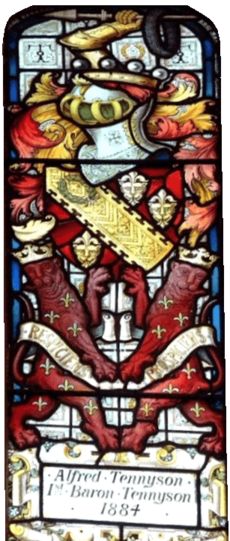
Tennyson's early poems, with their medieval themes and strong visual images, greatly influenced the Pre-Raphaelite Brotherhood. This was a group of English painters, poets, and critics. In 1848, two of them, Dante Gabriel Rossetti and William Holman Hunt, made a list of their artistic heroes. This list included Tennyson, whose work they used as subjects for their paintings. For example, the poem "The Lady of Shalott" was painted by Rossetti, Hunt, John William Waterhouse (three times!), and Elizabeth Siddal.
Works
Here is a list of some of Tennyson's works:
- Poems by Two Brothers (1826; written with Charles Tennyson)
- "Timbuctoo" (1829)
- Poems, Chiefly Lyrical (1830), which included:
|
|
- Poems (1832), which included:
|
|


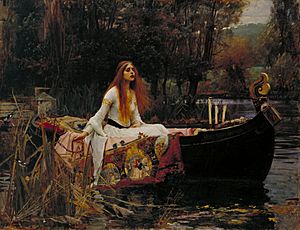

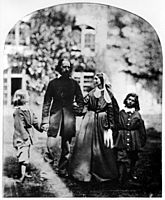
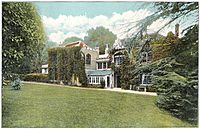

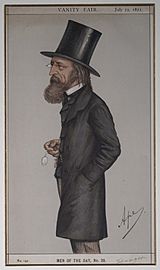
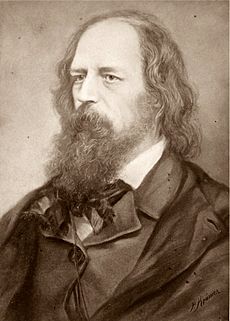

 In Spanish:
In Spanish: